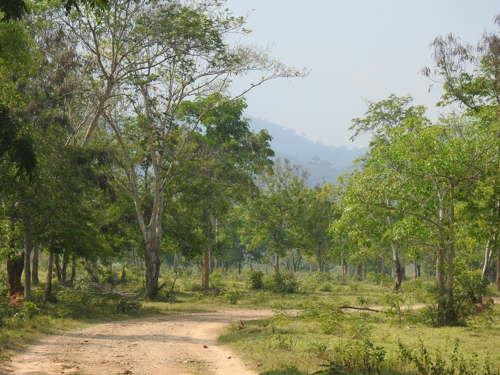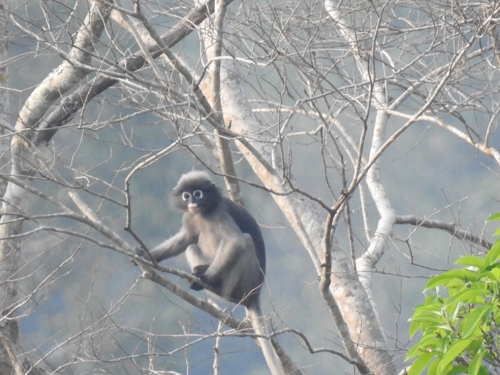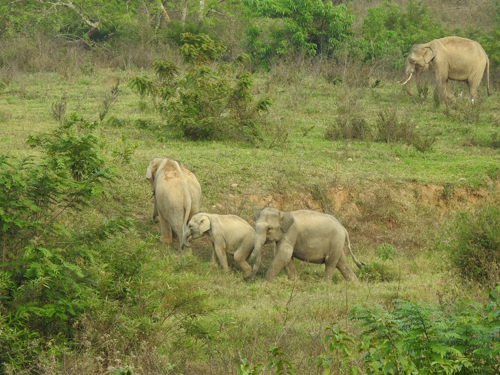Blog WHS Visits
WHS #831: Kui Buri NP
For my ‘tick’ of the Kaeng Krachan Forest Complex I choose Kui Buri National Park. Kui Buri (sometimes also spelled as ‘Kuri Buri’) was established only in 1999 after tensions between wild elephants and villagers escalated. The elephants’ former habitat had been taken over by pineapple plantations. The park now offers daily 'elephant safaris', where - with a bit of luck - one can observe the wild elephants from a distance. The WWF is still active here to further reduce human-elephant conflict.
The park lies about 1h15 from the pleasant seaside resort of Hua Hin. I used HuaHin Taxi for the return transfer – they are easy to communicate with and know the drill at Kui Buri. The wildlife viewing area is open to entering daily between 2 and 5 p.m. (though you will leave towards 6 p.m.) and requires hiring a 4WD truck and guide at the ticket office.
We arrived at 2.15 and I was driven into the park immediately. The noisy truck drove quite fast on the sandy roads and it was clear that we wouldn’t be seeing much along the way. They will bring you to one of the two main viewpoints, where you disembark and the waiting begins. These viewpoints are major tourist congregation sites, not the lovely camouflaged watchtowers that they use in Huai Kha Khaeng. Eventually, some 15 trucks and 50 tourists showed up at this viewpoint, the furthest. This clearly was an Indian-style safari, not a serene African one.
I barely even saw a bird. I was just sitting there and thinking about what rating I would give this site, it was so disappointing. After a while, I noticed some movement in the trees to my left: there were monkeys, endangered Banded leaf monkeys. They are very cute with their white ‘spectacles’ on their black faces. All other tourists were so focused on seeing elephants that they missed this, as did the guides for some time as they were not very observant either and mostly chatted with each other. Every car requiring its own ‘guide’ seems mainly to be a job creation scheme.
It wasn’t until 5 p.m. that a murmour went through the ranks of the guides: big mammals spotted in the distance (we were overlooking a very wide valley). They turned out to be Gaur, a.k.a. Indian bison (or ‘buffalo’ as the guides called them). Just a string of black dots moving on the horizon for those people without binoculars or superzoom cameras. Zooming in delivered views on their characteristic ‘white socks’ and general massive build.
Some crackling on the guides’ radios announced more activity: two elephants were seen from the other viewpoint! So all trucks and tourists had to move. As I, fortunately, had the truck to myself and not an elderly aunt or similar to wait for, we were quick off the mark. From the other viewpoint, the two elephants could be seen remarkably close. They were soon joined by a family of three, including a young. Their appearance didn’t last for more than 10 minutes, the original two stayed a bit longer. So just in the closing minute of our safari the park (or the elephants) had delivered.
Seeing wild elephants at Kui Buri has become harder over the years. Does it have to do something with the successful campaign to keep them away from the crops, so they withdraw deeper into the park? Limited access to locations certainly is one factor (they only have two main viewpoints in a vast park, both not far from the entrance and close to a dam being constructed). The other factor is the timing of the access: the animals will become more active towards dusk when the tourists already are ordered to leave.
The experience at Kui Buri I found quite exemplary for Thai national parks. Three of Thailand’s six current WHS are natural ones, but a lot more could be done to open them up in a sustainable manner. Overcrowding (leading to noise, pollution) and feeding of wild animals are prevalent (read this horrifying account). An approach to ecotourism is seriously lacking, which is so successful in countries like Costa Rica, Peru, and Brazil. Also, although the Asian elephant is an endangered species, in Thailand it still is often captured to be used for entertainment purposes (notably near Chiang Mai, but I also encountered a baby elephant being walked through the streets of Udon Thani).
Els - 26 February 2023


